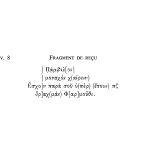| Artefact ID | 1476 |
| TM ID | TM 23832 |
| Findspot (DEChriM ID) | - () | Class | Textual |
| Material | Ceramic |
| Writing medium | Ostracon |
| Text content | Documentary |
| Language | Greek |
| Description | O.Bahria Div. 8; SB 20 14930: Fragment of a receipt |
| Selection criteria | Mention of Christian cult officials/institutions, Archaeological context associated with Christian markers |
| Date from | 410 |
| Date to | 411 |
| Dating criteria | Most Bahariya ostraca date from the 4th c. or Byzantine period. A small number can be placed in the 2nd or 3rd c. If in this case, the ostracon was indeed dated by the Oxyrhynchite era (see πζ = year 87 (?) on line 3), this could indicate the year 410/411, see Bagnall/Worp 2004. |
| Absolute/relative date | Relative date |
| Archaeological context | Discovered by Ahmed Fakhry during the excavation of the brick buildings around the temple of Alexander the Great (published 1942), alongside O.Bahria and the ostraca assigned to the “Dossier of Sarmates” and “Dossier of Dorotheos son of Marinos” by Wagner 1987. Wagner had discovered an envelope labeled "Bahria Oasis” containing photographs of 68 Greek, Coptic and Arabic ostraca in the archives of A. Fakhry, deposited at the DAI Cairo after his death. Of the 32 Greek ostraca photographs, 16 ostraca including this one remained unassigned to either dossier, titled O.Bahria Div. |
| Accession number | Location unknown |


 Json data
Json data




